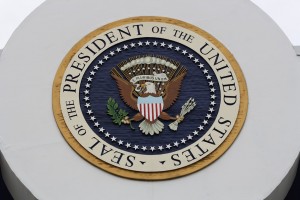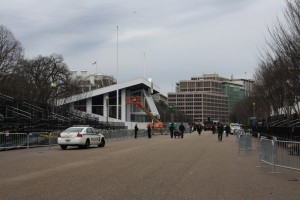By Alan Ladwig
 A delegation of members of Congress recently hammered the ceremonial nails to begin construction of the inaugural platform for the swearing-in of the new President. Before the platform assembly is completed, I have a suggestion for the Joint Congressional Committee on Inaugural Ceremonies: start the Inaugural Parade before the Congressional Luncheon!
A delegation of members of Congress recently hammered the ceremonial nails to begin construction of the inaugural platform for the swearing-in of the new President. Before the platform assembly is completed, I have a suggestion for the Joint Congressional Committee on Inaugural Ceremonies: start the Inaugural Parade before the Congressional Luncheon!
Planners would do well to remember that January is routinely the coldest month in Washington, D.C. Extremely cold temperatures on Inauguration Day are the norm. As the public begins to gather on The Mall, the average high is 43 degrees, while low temperatures can hover at a subfreezing 28 degrees. When the swearing-in ceremony begins at noon, temperatures soar to 37 degrees, accompanied by a below freezing wind chill.
Traditionally, the Congressional Luncheon takes place immediately after the swearing-in ceremony and before the parade. The new President, Vice President, members of Congress, the Supreme Court and associated VIPs head inside to the warmth of National Statuary Hall to chow down on a gourmet meal. In addition to lunch, the agenda features the unveiling of an official painting, speeches pledging cooperation to the new administration, the Smithsonian Chamber Players, the presentation of a crystal bowl or vase, and a congratulatory toast.
Meanwhile, waiting outside for the parade to begin are a half million-plus shivering citizens and over 15,000 parade participants that have been waiting in the cold since as early as 7:00 a.m. The hoi polloi stand around for hours in frigid weather while the VIPs are warm and toasty indoors, gorging themselves on grilled bison, exotic fowl, lobster, complementary wines, and exquisite desserts. The whole thing is like a scene from a Charles Dickens novel.
With a full stomach and wine buzz, the President and First Spouse eventually take their positions as Grand Marshals of their very own parade. Unfortunately, by the time they emerge – often as late as 3:30 – the bleachers and spots along the parade route have room to spare. Tired of waiting, hundreds, if not thousands, of spectators surrendered to their frozen, hungry and restless kids and headed for home.
With 100 entries, including military units, civilian organizations, marching bands, floats, and over 200 horses, the parade procession lasts more than three hours. It’s dusk by the time the last marching band passes the Presidential viewing stand.
The only inauguration activity specifically mandated by the U.S. Constitution is that “the president make an oath or affirmation before that person can ‘enter on the Execution’ of the office of the presidency.” All the other activities have evolved as traditions.
 The Inaugural Parade dates back to 1805 when workers and musicians from the Navy Yard joined President Thomas Jefferson as he road his horse from the Capitol to the White House. Except for President Reagan’s second inauguration when the parade was cancelled due to extreme weather, every president has led a parade. As traditions go, the parade has significant seniority over the Congressional Luncheon, which didn’t start until 1953.
The Inaugural Parade dates back to 1805 when workers and musicians from the Navy Yard joined President Thomas Jefferson as he road his horse from the Capitol to the White House. Except for President Reagan’s second inauguration when the parade was cancelled due to extreme weather, every president has led a parade. As traditions go, the parade has significant seniority over the Congressional Luncheon, which didn’t start until 1953.
There is no reason that the Congressional event can’t take place after the parade. Since they are going to be partying all night, the last thing the attendees need is another round of drinks and the added calories of an epicurean meal. Better they stick to a more modest buffet. They can still hang the official painting. The Smithsonian Chamber Players can still perform. The Congressional leadership can still give speeches and present the president with lovely parting gifts. They’ll still have plenty of time to get gussied up for the inaugural balls.
There is one more important reason to change up the order of events – the safety and security of the spectators and public officials. This unconventional presidential campaign has seen an outpouring of populist patriots and anger with the political elite. One of the presidential candidates has charged that the election is rigged and he may not be willing to concede. There have been frightening threats that his opponent “needs to be taken out.” With such rancor is it really a good idea to make several hundred thousand impatient and hungry people stand around for three hours in freezing weather so they can wave at the new president?
The inaugural parade offers an once-in-a-lifetime opportunity for the thousands of marchers who have traveled to D.C. on their own dime from all 50 states and the District of Columbia. To be selected to participate in the parade is an exceptional achievement. The marchers deserve to be honored and cheered by standing room only crowds.
If inauguration planners really want to show that Congress cares about the public’s wellbeing and safety, they should launch the Inaugural Parade immediately after the swearing-in ceremony and before the Congressional Luncheon. This would represent change we can all believe in, and besides, everyone loves a parade!
Alan Ladwig is a retired Federal employee. He was the lead coordinator for two NASA entries in President Obama’s second inauguration.


